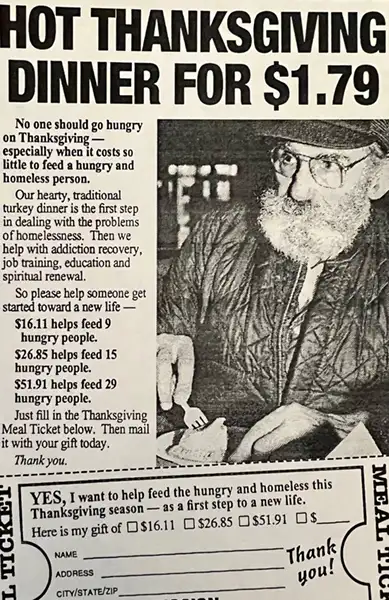
If you’ve worked in the rescue mission world for more than, oh … say, one week, this question probably sounds blasphemous.
Drop the meal offer? Are you crazy?
Well, before you break out the tar and feathers, let’s pause a bit and start by talking about the origins of the meal offer. Back in the 1980s, rescue missions – with the help of a handful of fundraising agencies – got serious about fundraising, and the meal offer became the cornerstone of those fundraising efforts.
And what is the meal offer, you may ask? It’s the fundraising ask that sounds somewhere along the lines of, “Complete Thanksgiving dinner = $1.79,” or “Feed a hungry person for just $1.79.”
This is extremely familiar territory now, but in those early days, it was groundbreaking. Because rescue missions were just getting started with this approach, the meal offer was wildly successful. Back then, when I was working for Grizzard, donor acquisition campaigns almost always made money.
Fast forward to today. The meal offer is so common that even raising the idea of moving beyond it is considered anathema.
Now don’t misunderstand me. I don’t want to completely walk away from the meal offer. It has several key advantages and older donors still respond to that offer. First, it gives donors something tangible. They know that when they send your mission a gift, they’re providing a real service to someone in need. Also, in this noisy marketing environment, it’s short and to the point. Moreover, it gives donors the sense that they’re getting a bargain when donating to your mission.
So why am I talking about moving beyond it? For starters, it’s been used for so long that it’s become, well, a little stale. Donor acquisition campaigns usually don’t make money, and results continue to decline. (Quick side note: Our partners ARE making money!)
Also, it doesn’t come close to encapsulating all that rescue missions do. Absolutely, rescue missions feed hungry people, but they do a heck of a lot more than that. Rescue missions change lives. That may start with a meal, but it involves making a long-term investment in people in the form of case management, counseling, pastoral care, and various residential programs.
Moreover – and this is key – the fundraising landscape is changing, and people in many cities across the country are experiencing charity fatigue. In Los Angeles, for example, the homeless population isn’t limited to just Skid Row anymore. There are tent cities spread across the entire metro area. With such a pressing need, if people are going to give to help the homeless, they want to know that they’re doing more than just giving someone a meal.
They want to know that their charitable gift is truly making a difference in people’s lives and in their community.
Now, you might say, “Well, yeah, but that’s LA. We all know LA is crazy.” Okay, fair enough. But like it or not, the rest of the country is often downstream from cities like LA. And in this environment where the competition for charitable dollars is becoming extremely competitive, we can’t afford to just say, “Well, that’s what we’ve always done.”
So what am I proposing? I’m so glad you asked! In the interest of keeping this message from being way too long, I’ll use my next news alert to get into some of what we at Delia Martín are looking to test in the months ahead. Stay tuned!